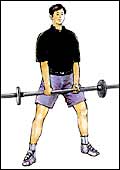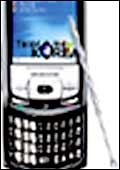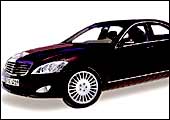 |
 |
|
|
If
you work out with weights regularly, you're likely to have a few
favourite exercises. Many of my male co-gymmers like the bench-press.
In the confines of the men's locker room some of them have even
confided to me that the bench-press makes them feel macho and
strong, even studly! Others prefer arm exercises, biceps curls
and triceps press-downs that pump up the big guns to look cool
in fitted T-shirts. That's probably why every summer, that's what
you see most men doing at their gyms; pumping up their arms. Women
at my gym have very different priorities. Many of them love doing
lower-body exercises to tone their hips, glutes, thighs and calves.
My personal favourite exercise is the dead-lift. It's an exercise
that looks deceptively simple and essentially involves picking
up a barbell with weights but is actually a compound exercise
that works out the muscles of your thighs, hamstrings, hips and
buttocks, abdomen and back. If you haven't incorporated the dead-lift
in your workout routine, I'd suggest you consider doing so because
it indeed is one of the most comprehensive workouts you could
do for your lower body.
Lately, I've been doing variations on the
dead-lift theme and my current favourite is the Sumo dead-lift.
As you may have guessed from the name, the Sumo lift involves
mimicking the stance of Sumo wrestlers-feet wide with toes pointing
outward. In the initial position, you lower your body from the
buttocks, knees bent and grip the bar roughly at shoulder width
(as in the illustration). The second part of the exercise is the
movement where you straighten your legs to stand up. Your back
must be in its natural arch throughout the exercise or else spinal
injuries can occur. In fact, improper form while dead-lifting
can cause slipped discs, particularly in the lumbar (or lower)
regions of the back. A couple of tips to ensure good form: look
upwards instead of straight ahead to ensure that your back remains
naturally arched and not bent; while rising in the second and
final stage of the exercise, mentally push your feet through the
floor so that your leg muscles (and not the back muscles) are
engaged when you do the exercise; also while rising, push your
hips forward, particularly if you're lifting heavy as this will
help balance you and reduce pressure on the spine.
On another topic, reader Prashant Dhamal,
asked me whether as an asthmatic he could exercise in the gym.
My suggestion to Prashant would be to consult a medical professional
before he does so. Readers with similar queries could also check
out this website that I found has a wealth of information on exercising
for asthmatics: www.lung.ca/asthma/exercise/.
-Muscles
Mani
write to musclesmani@intoday.com
Caveat: The physical exercises described
in Treadmill are not recommendations. Readers should exercise
caution and consult a physician before attempting to follow any
of these.
ALL
ABOUT OSTEOARTHRITIS
Osteoarthritis,
also called degenerative joint disease, is the most common of
the more than 100 forms of arthritis, and it affects 30 to 40
million Americans. Nearly everyone over 40 has signs of osteoarthritis
that show up on an X-ray. Says Dr K.L.Kalra, Senior Consultant,
Sir Ganga Ram Hospital: "After heart-related ailments, osteoarthritis
is one of the biggest diseases in India. The rate of incidence
is as high as 12 per cent of the population."
What Is It: Osteoarthritis (OA) is
a permanent deterioration of cartilage layers between bones that
shield the joint from impact, causing pain and loss of movement.
The ailment is not a symptom of "just getting old";
the disease affects people in all age groups. Before age 45, more
men than women suffer from it.
Causes: Some kinds of OA are known
to be hereditary, including the common form in which enlargement
of the knuckles takes place. Dr Kalra says: "Prominent causes
of osteoarthritis are joint damage by chronic obesity, lack of
physical activity, diabetes and injury. In most people, cartilage
breakdown is due to mechanical ('wear and tear') and biochemical
effects."
Symptoms: The main symptom associated
with osteoarthritis is stiff and painful joints. In early stages,
joints may ache after physical work. The disease can occur in
any joint. Most often it occurs at knee, wrist, neck, hip, ankle
and spine.
Treatment: There are various treatment
options for osteoarthritis-joint and muscle exercises, anti-inflammatory
drugs and rotating platform knee surgery. According to Dr Kalra,
"RP Knee is a widely used therapy in India. The surgery costs
around Rs 1.5 lakh." The replaced knee performs with less
wear and is more flexible compared to the fixed bearing type.
However, losing weight and medication can help reduce the pain
considerably.
-Manu Kaushik
PRINTED CIRCUIT
The Ultimate Digicam
H2D39
 What
adding clock-speed to computer chips was in the early 2000s (a
great sales tactic, at least in the minds of these companies),
adding megapixels to the resolution of digital cameras is today.
Well, in a beat-this-if-you-can move the best-known name in photography,
Hasselblad has launched the H2D39, a 39 (yup, that's no typo,
39) megapixel digital camera. It also boasts other features such
as improved colour correction and colour profiling. The resolution,
however, will likely be its selling point. For those who can afford
it, that is. What
adding clock-speed to computer chips was in the early 2000s (a
great sales tactic, at least in the minds of these companies),
adding megapixels to the resolution of digital cameras is today.
Well, in a beat-this-if-you-can move the best-known name in photography,
Hasselblad has launched the H2D39, a 39 (yup, that's no typo,
39) megapixel digital camera. It also boasts other features such
as improved colour correction and colour profiling. The resolution,
however, will likely be its selling point. For those who can afford
it, that is.
Price: Starts at £21,500 (Rs 16,77,000)
 The
First Skype Phone(s) The
First Skype Phone(s)
Skype Internet Phone Plus and Samsung M 8000
The
future of telephony, especially long-distance, is here. For those
who believe Skype is the future of the aforementioned, you are
right, but this is Skype with a twist. Creative Labs has unveiled
a Skype phone which hooks up to the net through an Ethernet cable.
Samsung has done one better with a phone (without wires) that
allows people to make calls over high-speed wireless broadband.
Add (or mix and match) the two, and you end up with a Skype-on-WiMax
device, just the kind of thing we had in mind.
Price: By year-end as phones are prototypes
Intel Inside
The New Macs
 At
the recent Macworld Expo at San Francisco, Apple's Steve Jobs
unveiled the company's first Intel-chip based computers including
a Pentium 4 dual core iMac (just right for gamers who have thus
far shunned iMacs) and the MacBook Pro (with dual-core Pentium
M). However, given Apple's rather limited reseller network in
India, these products are unlikely to be available before March. At
the recent Macworld Expo at San Francisco, Apple's Steve Jobs
unveiled the company's first Intel-chip based computers including
a Pentium 4 dual core iMac (just right for gamers who have thus
far shunned iMacs) and the MacBook Pro (with dual-core Pentium
M). However, given Apple's rather limited reseller network in
India, these products are unlikely to be available before March.
Price: the iMacs start at $1,299 (Rs 58,455) and the MacBooks
at $1,999 (Rs 89,955)
 Car/Computer Car/Computer
The New Mercedes S Class
Printed
circuit normally avoids cars (ugh! mechanical monstrosities) but
just had to make an exception for the new S because it boasts
more computing power than your desktop (or laptop). Then, there
are the tech-enabled features that even writers of retro SF would
have been hard-pressed to come up with: radar assisted cruise
control that allows drivers to maintain the ideal braking distance
from the car ahead; pre-safe occupant protection which anticipates
accidents (for those drivers who manage to override the 20-odd
computers that normally help in avoiding them) and starts deploying
safety features; and dynamic multi-contour seats. All that for
a not very significant premium over the existing S makes it a
steal of sorts.
Price: Rs 75 lakh - Rs 1.5 crore
-Compiled by Kushan Mitra
|






 W
W The
First Skype Phone(s)
The
First Skype Phone(s) At
the recent Macworld Expo at San Francisco, Apple's Steve Jobs
unveiled the company's first Intel-chip based computers including
a Pentium 4 dual core iMac (just right for gamers who have thus
far shunned iMacs) and the MacBook Pro (with dual-core Pentium
M). However, given Apple's rather limited reseller network in
India, these products are unlikely to be available before March.
At
the recent Macworld Expo at San Francisco, Apple's Steve Jobs
unveiled the company's first Intel-chip based computers including
a Pentium 4 dual core iMac (just right for gamers who have thus
far shunned iMacs) and the MacBook Pro (with dual-core Pentium
M). However, given Apple's rather limited reseller network in
India, these products are unlikely to be available before March. Car/Computer
Car/Computer